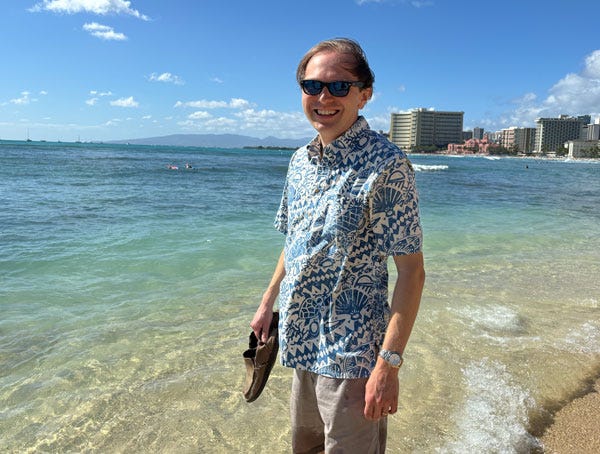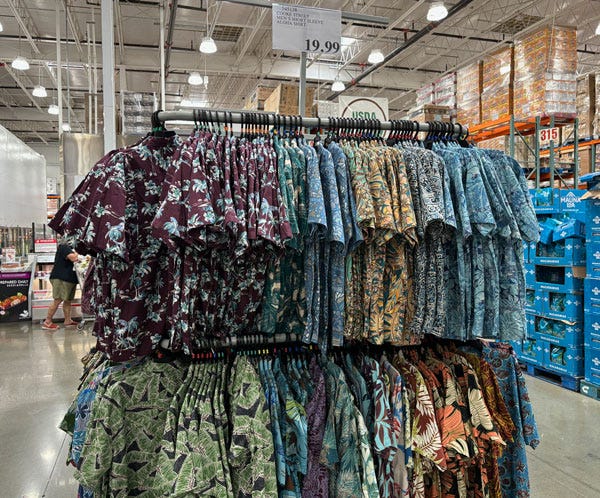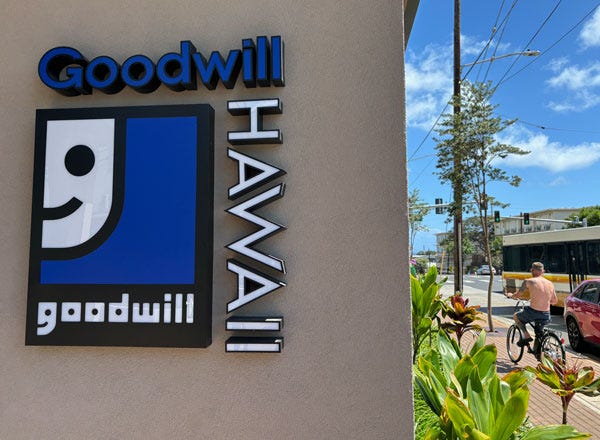Wednesday Walk: Imported Aloha
Taking time away, making Hawaiian staples elsewhere, thinking about Indigenous issues
Welcome to Willoughby Hills!
Every Wednesday, I offer a few short ideas that I hope will inspire you to do some more reading, thinking, and exploring. Let’s take a little walk together and see where the path leads…
Unplugged
Last week, I wrote about having just landed in Hawai’i after flying on the longest nonstop flight in the U.S. Today, I am writing a bit jet lagged and tired, just returned back to Massachusetts.
I had originally planned to keep up my usual writing schedule of publishing posts on Wednesdays and Sundays, but when I got to Hawai’i, it was very hard to get any work done, so I skipped Sunday’s post.
My wife, kids, and I were spending time together as our family. We visited with other family members who live in Hawai’i, stayed with some friends who were also visiting, and met up with friends we had locally.
We are fast approaching the closing on our new house, so I couldn’t completely avoid email and keeping up with real world “work” in some ways, but I tried to limit my communication to urgent real estate matters. I saw lots of emails and other messages come through, but I really tried to fully disconnect and not respond to much.
I realized that my only choice was to take an all or nothing approach: if I answered one email, I would feel obligated to answer more and soon I might find myself working for two or three hours. Instead, I read books, cooked food, and hung with my loved ones.
I realize that everyday can’t be like this last week. Life is about balance and work needs to get done. But I think we’ve overemphasized hustle culture in America and many of us have internalized the idea that we always need to be working and don’t deserve or need downtime. But it’s exactly those times of calm that prepare us for the next periods of action.
I very much appreciated being unplugged and it makes me feel more recharged for the weeks and months ahead now!
#NoNewClothes- Overseas Aloha Shirts
I’ve written before about how I inherited a number of high quality Aloha shirts from a family friend when her husband passed away. (That’s one of them that I’m wearing in the photo at the top of this post). I don’t wear them as often as I used to, but I always liked Hawaiian shirts and definitely enjoy seeking out authentic and high quality ones.
While in Hawai’i, we stopped into Costco (twice actually), as it can be a very economic place to get local souvenirs: everything from macadamia nuts to locally grown coffee sell in Costco. I was especially excited to see a rack of Aloha shirts selling for $20! They seemed high quality like a good bargain.
That is, of course, until I took a closer look.
It turns out that the Aloha shirts selling at Costco, like nearly every garment we purchase in any store these days, was actually imported. In this case, the tag says the shirt was from Cambodia.
I’ve been avoiding buying overseas clothing since interviewing Amelia Pang a few years ago and learning about the labor issues with garment factories in China. Furthermore, I have been inspired after recently talking to Chilean fashion designer Fran Gajardo about the fashion waste she witnesses in her country (if you haven’t heard that podcast from last week yet, I encourage you to take a listen).
Something about buying a seemingly authentic Hawaiian souvenir that’s not actually Hawaiian felt wrong. Is it really an “Aloha shirt” if it was purchased in Hawai’i but made in Cambodia?
Throughout my vacation, my mind kept going back to those non-Hawaiian shirts and I wondered if I was being too narrow minded thinking that way. Maybe Aloha shirts never even came from Hawai’i?
It turns out, I found my answer at Goodwill Hawai’i!
You probably know by now that I love thrift stores, but I especially love visiting them in Hawai’i as I can find unique items or discounted clothing that might be selling in gift stores for twice the price.
In the Aloha shirt section of Goodwill (yes, there is literally an entire rack dedicated to them at this store), I found an older Cooke Street shirt that was “Made in U.S.A.”
I checked the tags on some of my older Aloha shirts and found the same thing: several either were made in America or sometimes even spelled out specifically “Made in Hawai’i.” And as we shopped all week, I began to check more tags of other brands. Another brand of Aloha shirts seemed to make all of their wares in Korea. Even if Korean labor issues are better than places like China or Bangladesh, it’s still not made in Hawai’i.
Of course, discerning the true origin of any modern product gets dicey. A made in Hawai’i shirt is likely not made with Hawaiian cotton (the variety that’s grown there is not useful for making fabric).
Still, it felt worth noting that globalization, consolidation, and all of the other problems of our modern fashion industry are just as present on islands in the middle of the Pacific as they are in New York, London, Paris, or Tulsa.
Indigenous Lands
This trip to Hawai’i and the ongoing assault against Palestinians and Palestinian land also has me thinking deeply about Indigenous traditions around food and land stewardship.
The conventional American agriculture model has been spreading around the world for more than half a century, and it’s a system that fundamentally disrespects the land, killing off native vegetation and pumping the soil and air with toxic chemicals.
I’ll be writing more about Indigenous agriculture soon, but for now, I wanted to share some ideas from others on these topics.
(who I interviewed on the podcast last year) recently wrote a great piece about who is using our land and how. Beth writes:“In 2022, White people controlled more than 80% of the nation’s wealth.
And if you look at just land ownership in the United States, 96 percent of land owners are white. They control 97 percent of the value and 98 percent of the acres of all privately owned land in the US.”
She goes on to talk about how Indigenous cultures, when they are allowed to stay on their lands, are naturally good land stewards because of their deep connection to their place:
“Worldwide, Indigenous communities govern or own 30% of the world’s land. The majority of those tracts are considered to be in “good ecological condition” by the United Nations. Lands managed by Native communities have equal or higher biodiversity than protected areas like National Parks and Forests, and some studies have found that more than a third of all the “Intact Forest Landscapes” in the world are on Indigenous-controlled lands.”
Her entire piece is worth reading in full, and it ties in nicely to a video posted by Jenan Matari this week that’s worth watching.
Jenan is a Palestinian-American who has been making incredible educational content about Palestinian issues for a few years now. If you’re not already, please follow her.
In this new video, she talks about how human suffering is directly tied to earth suffering and how all of our lands are connected. It’s a powerful message, and one that I hope will stick with all of us as we continue to bear witness to the genocide of Palestinians in Gaza and native communities worldwide.
Indigenous cultures spent thousands of years developing best practices to live sustainably with what their land provided. Whether it’s Palestinians, Hawaiians, or Native Americans on the Mainland, I hope that we all begin to recognize the importance of honoring those voices and traditions and learning from them. Our planet depends on it.
I publish new issues every Wednesday and Sunday. Sign up to always receive the latest issue and support my work:
Other Wednesday Walks
If you’ve missed past issues of this newsletter, they are available to read here.










